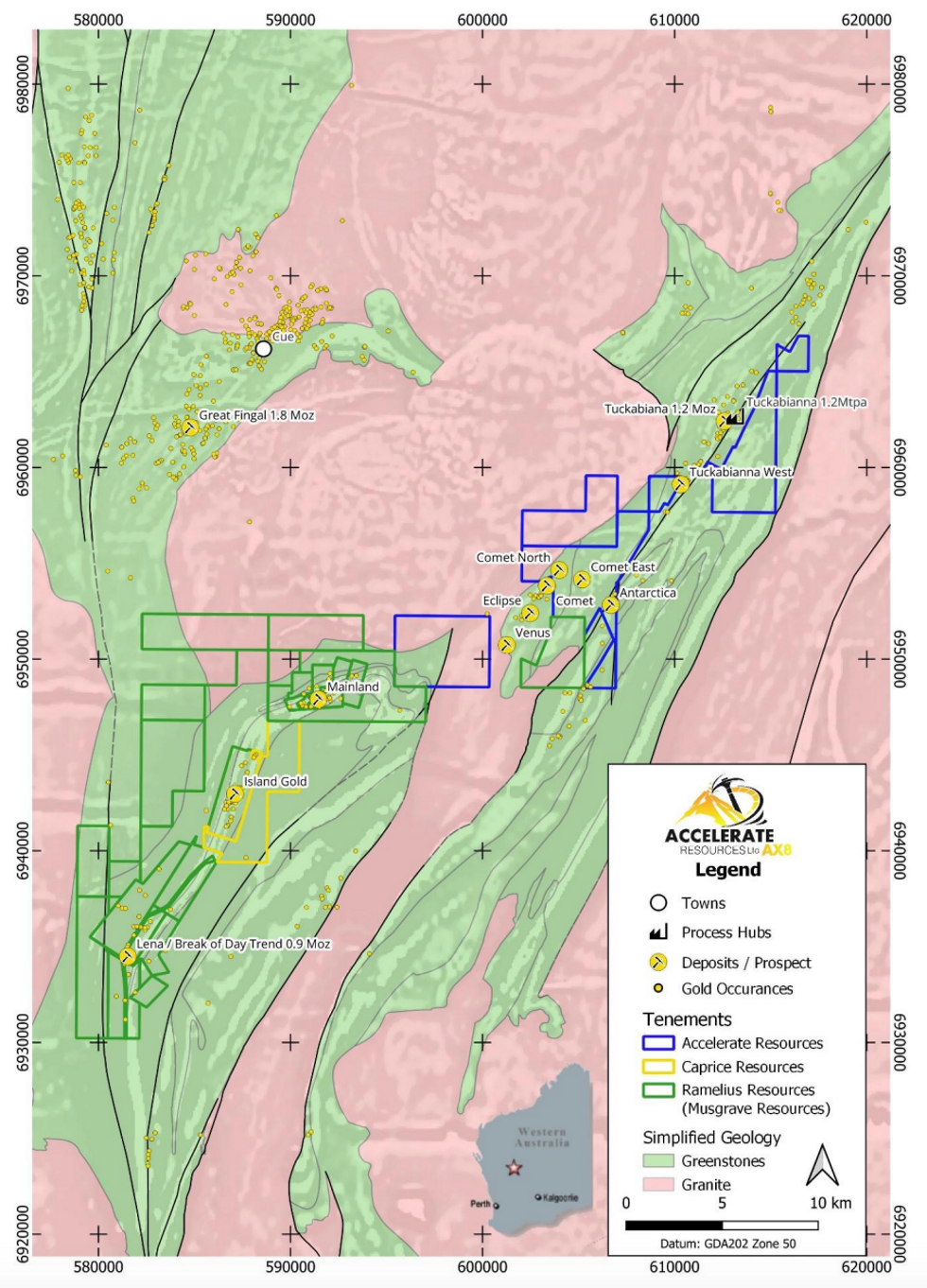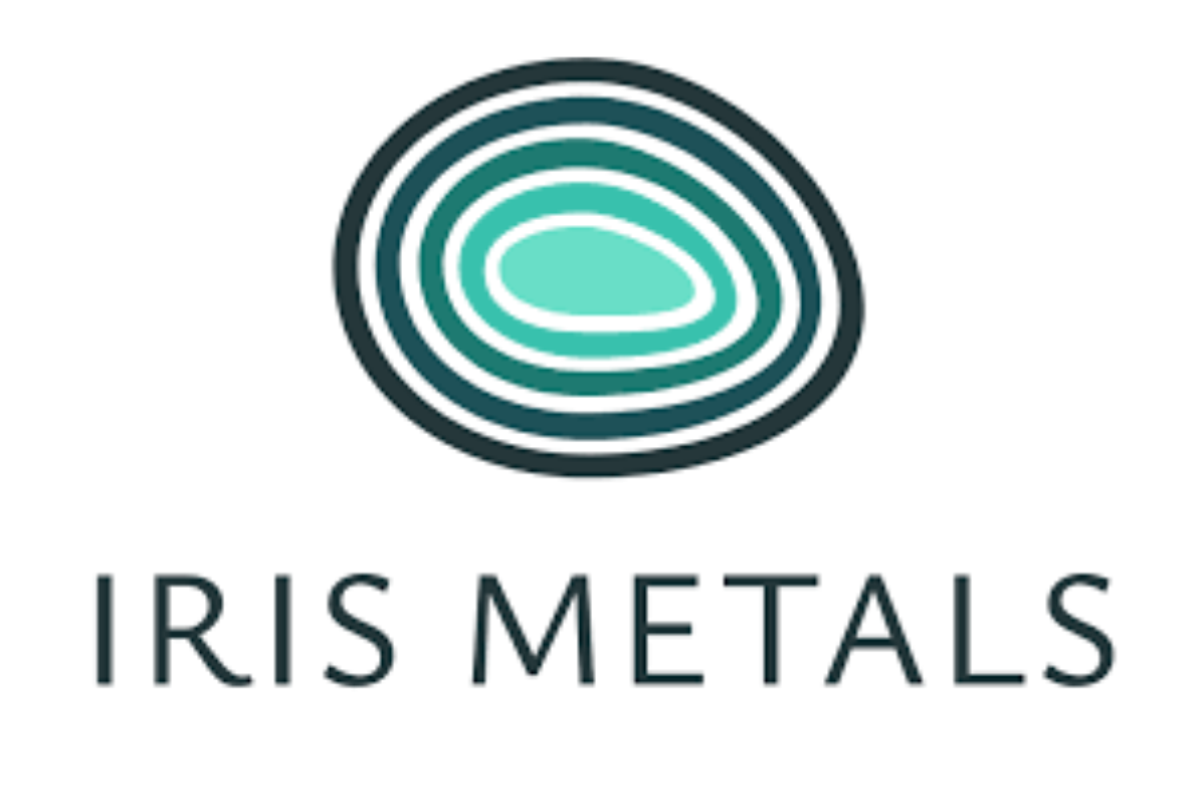
February 23, 2025
Accelerate Resources Limited (“AX8”, “Accelerate” or the “Company”) is pleased to announce the commencement of a gold prospectivity review and reinterpretation at its Comet Gold Project (“Comet”) inspired by the recent exploration success by Caprice Resources at their Island Gold Project located 10km to the south-west in Western Australia’s Murchison Goldfield.
Key Points
- Accelerate commences comprehensive review of its Comet Gold Project in the Murchison region following the recent high-grade gold discovery at Caprice Resource’s (ASX: CRS) Island Gold Project, just 10km to the south-west.
- The 100% owned Comet Gold Project hosts significant gold mineralisation within Banded Iron Formation (BIF) lithologies, similar to those at The Island Gold Project.
- Notable previous drill intercepts at Comet include 9m at 3.89 g/t Au, 4m at 7.08 g/t Au and 6m at 2.29 g/t Au (see details in main body text).
- Accelerate’s 100% ground holding represents 73km2 with over 26km of prospective strike, strategically situated 19 km from Westgold Resources 1.2 million tonne per annum Tuckabianna gold mill in the +20Moz Murchison Goldfields of WA
Building on the Caprice high-grade gold discovery and the historic success of former ASX- listed Musgrave Minerals (now Ramelius Resources ASX: RMS) along the Break of Day trend, Accelerate is advancing its investigation of Comet by prioritising Banded Iron Formation (BIF) mineralisation at the Comet East, Comet North and the Antarctica Prospects (Figure 1). The review is expected to be complete by end of the Quarter and results will guide next steps in exploration including drill testing of BIF-hosted mineralisation targets along strike of the Caprice discoveries and the Break of Day trend.
Gold Targets
Drilling campaigns by Accelerate and historic explorers, including Silverlake Resources, have delivered significant assay results across three prospects at Comet, with the most recent program completed in 2020 during the peak of the COVID-19 pandemic.
The Comet East Prospect (Figure 2) is situated approximately 1 km east of the former Comet-Eclipse Gold Mine of Westgold Resources (ASX: WGX), where wide-spaced shallow drilling during the 1990’s intersected significant gold mineralisation including 4m at 7.08 g/t Au from 27m (PRB305), and 3m at 4.53 g/t Au from 60m (PRC269)1.
 Figure 1: Comet Gold Project in relation to the Island Gold and Break of Day Projects
Figure 1: Comet Gold Project in relation to the Island Gold and Break of Day ProjectsClick here for the full ASX Release
This article includes content from Accelerate Resources, licensed for the purpose of publishing on Investing News Australia. This article does not constitute financial product advice. It is your responsibility to perform proper due diligence before acting upon any information provided here. Please refer to our full disclaimer here.
AX8:AU
The Conversation (0)
17h
Top 5 Australian Mining News Stories of 2025
From boardroom decisions to billion-dollar buildouts, 2025 was a defining year for Australian mining companies as they navigated changes in the global landscape.Escalating trade tensions, shifting US tariff policies and heightened geopolitical risk reshaped export strategies and investor... Keep Reading...
18 December
Iris Secures Right to High-grade Tungsten Project, Montana USA and Update on Capital Raising
IRIS Metals Limited (ASX: IR1, “IRIS” or “the Company”) is pleased to announce it has executed a binding Heads of Agreement (HOA) with Finley Mining Inc for the exclusive right to farm-in to the Finley Basin Tungsten Project (Tungsten Project) located in Granite County, Montana, USA. This... Keep Reading...
16 December
Mark These Tax-loss Selling Dates on Your Calendar
As the end of 2025 nears, investors may want to consider how they can use tax-loss selling to their benefit.Buying stocks low and selling them high is ideal, but sometimes investments go sour. In such cases, all hope is not lost — at the end of the year, investors can sell investments that... Keep Reading...
01 December
Australia Minerals Council Blasts EPBC Bill’s Lack of Environment and Mining Balance
“The deal between the Federal Government and the Greens to pass the Environment Protection Reform Bill 2025 and related bills is an inferior and disappointing outcome which fails to strike the right balance between protecting Australia’s unique environment while enabling responsible and... Keep Reading...
28 November
Completion of the Acquisition of the Webbs Consol Silver Project
Rapid Critical Metals Limited (‘Rapid,’ ‘RCM’ or ‘Company’) is pleased to announce that it has completed the acquisition of the Webbs Consol Silver Project (Webbs Consol) in northeast New South Wales, comprising EL 8933 and EL 9454 from Lode Resources Limited (ASX: LDR) (Lode Resources). The... Keep Reading...
19 November
Red Mountain Mining Successfully Lists on the US Stock Market with a Strong Trading Debut Up 36%
Red Mountain Mining Limited (ASX: RMX, US CODE: RMXFF, or “Company”), a Critical Minerals exploration and development company with a growing portfolio in Tier-1 Mining Districts in the United States and Australia, is pleased to announce that RMXFF successfully commenced trading on the OTCQB this... Keep Reading...
Latest News
Interactive Chart
Latest Press Releases
Related News
TOP STOCKS
American Battery4.030.24
Aion Therapeutic0.10-0.01
Cybin Corp2.140.00





